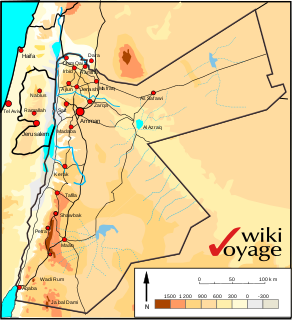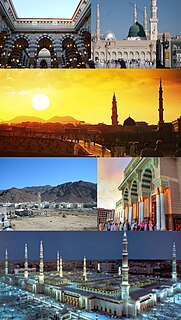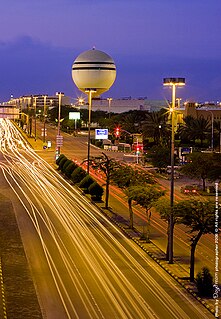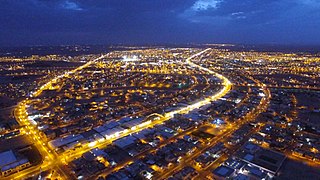
Jordan is situated geographically in Southwest Asia, south of Syria, west of Iraq, northwest of Saudi Arabia, east of Palestine and the West Bank. The area is also referred to as the Middle or Near East. The territory of Jordan now covers about 91,880 square kilometres (35,480 sq mi).

The Kingdom of Saudi Arabia is a country situated in Southwest Asia, the largest country of Arabia, by the Arabian Peninsula, bordering the Persian Gulf and the Red Sea, north of Yemen. Its extensive coastlines on the Persian Gulf and Red Sea provide great leverage on shipping through the Persian Gulf and the Suez Canal. The kingdom occupies 80% of the Arabian Peninsula. Most of the country's boundaries with the United Arab Emirates (UAE), Oman, and the Republic of Yemen are undefined, so the exact size of the country remains unknown. The Saudi government estimate is at 2,217,949 square kilometres, while other reputable estimates vary between 2,149,690 and 2,240,000 sq. kilometres. Less than 7% of the total area is suitable for cultivation, and in the early 1960s, population distribution varied greatly among the towns of the eastern and western coastal areas, the densely populated interior oases, and the vast, almost empty deserts.

Medina, officially Al Madinah Al Munawwarah and also commonly simplified as Madīnah or Madinah, is the second-holiest city in Islam and the capital of the Medina Province of Saudi Arabia. As of 2020, the estimated population of the city is 1,488,782, making it the fourth-most populous city in the country. Located at the core of the Medina Province in the western reaches of the country, the city is distributed over 589 square kilometres (227 sq mi), of which 293 square kilometres (113 sq mi) constitutes the city's urban area, while the rest is occupied by the Hejaz Mountains, empty valleys, agricultural spaces and older dormant volcanoes.

The Arabian Peninsula simplified Arabia is a peninsula of Western Asia, situated northeast of Africa on the Arabian Plate. At 3,237,500 km2 (1,250,000 sq mi), the Arabian Peninsula is the largest peninsula in the world.

Riyadh is the capital of Saudi Arabia and the largest city on the Arabian Peninsula. Located in the center of the an-Nafud desert, on the eastern part of the Najd plateau, the city sits at an average of 600 meters (2,000 ft) above sea level, and receives around 5 million tourists each year, making it the forty-ninth most visited city in the world and the 6th in the Middle East. Riyadh had a population of 7.6 million people in 2019, making it the most-populous city in Saudi Arabia, 3rd most populous in the Middle East, and 38th most populous in Asia.

The Kingdom of Bahrain consists of Bahrain Island and 33 of the p37 Bahrain Islands, lying in the Persian Gulf's Gulf of Bahrain off the north shore of Asia's Arabian Peninsula. Bahrain's capital city is Manama. The islands are about 24 kilometers (15 mi) off the east coast of Saudi Arabia and 28 kilometers (17 mi) from Qatar. The total area of the country is about 694 square kilometers (268 sq mi), about four times the size of the District of Columbia.

Najd, or the Nejd, forms the geographic center of Saudi Arabia accounting for about a third of the country's modern population and, since the Emirate of Diriyah, acting as the base for all unification campaigns by the House of Saud to bring Arabia under a single polity and under the Salafi jurisprudence.

The Qassim Province, also known as the Qassim Region, and officially the Emirate of Al-Qassim Province, is one of the 13 provinces of Saudi Arabia. Located at the heart of the country near the geographic center of the Arabian Peninsula, it has a population of 1,370,727 and an area of 58,046 km². It is known to be the "alimental basket" of the country, for its agricultural assets.

Dammam is the sixth-most populous city in Saudi Arabia after Riyadh, Jeddah, Mecca, Medina and Khamis Mushait. It is the capital of the Eastern Province. With a total population of 1,252,523 as of 2020. The judicial and administrative bodies of the province, in addition to the administrative offices of other minor governmental departments functioning within the province, are located in the city. The word itself is generally used to refer to the city, but may also refer to its eponymous governorate.

Buraidah is the capital of Al-Qassim Region in north-central Saudi Arabia in the heart of the Arabian Peninsula. Buraydah lies equidistant from the Red Sea to the west and Persian Gulf to the east. Its known for its dates festival which is the biggest in the world with various types of dates. It has been called the city of dates. On November 8, 2021, the United Nations Educational, Scientific and Cultural Organization "UNESCO" included the city of Buraidah within the UNESCO Network of Creative Cities, in the field of gastronomy.

Unaizah or officially The Governorate of Unaizah is a Saudi Arabian city in the Al Qassim Province. It lies south of the province capital Buraydah and north of Riyadh, the capital of the Kingdom of Saudi Arabia. It is the second largest city in Al-Qassim Province with a population of 163,729.

Rass is a Saudi Arabian City, located in Al Qassim Province. It lies southwest of Buraydah, the capital of the province and north of Riyadh, the national capital.
Al Qunfudhah, also known as Kunfuda, is a Saudi city in the Tihamah region on the coast of the Red Sea. Its population is the fourth largest in Makkah Province, the area of the governate is estimated at 5,195 km², which occupies about 3.65% of the area of the region and is ranked ninth among the governorates of the region in terms of area. It is also one of the large sea ports of the Kingdom of Saudi Arabia on the Red Sea. Al Qunfudhah was founded in 1311 A.C-709 Hijri according to the ancient sources.

Wadi Hanifa, historically known as Wadi al-Arad, is a wadi (valley) in the Najd region, Riyadh Province, in central Saudi Arabia. The valley runs for a length of 120 km (75 mi) from northwest to southeast, cutting through the city of Riyadh, the capital of Saudi Arabia. A string of towns and villages lie along the valley, including Uyaynah, Irqah and Diriyah. The historical city of Riyadh itself is on the northeastern side of the wadi, but the city has now expanded across Wadi Hanifa, with the sub-municipalities of Al-Shifa and Al-Urayja on its southwestern side.
Harmah is a city in Riyadh Province, Saudi Arabia, chaired by Mr. Saud Bin Abdulaziz Almadi. It is considered one of the most important historical cities in Najd. It is located 211 kilometres (131 mi) by road northwest of Riyadh, next to the city of Al Majma'ah. At the 2011 census it had a population of 9,011 people.

Az Zulfi is a city in Riyadh Province in central Saudi Arabia, about 260 kilometres northwest of Riyadh. It is connected by Roads 418 and 535 which both link with the main Highway 65 which connects Riyadh to Buraidah which is about 101 kilometres by road to west of Al Zulfi. Zulfi also forms a governorate of Riyadh Province. The Al-Yamama/Tuwaiq mountain range begins in the desert to the north of Al Zulfi.

Highway 65 is a major north-south controlled-access highway in central Saudi Arabia, spanning 1,427 km. Popularly known as the Riyadh–Qassim Expressway, Highway 65 connects Howtat Bani Tamim to Qurayyat and further to the Al Hadithah border with Jordan, while providing connections to or passing through Riyadh, Majma'ah, al-Ghat, Zulfi, Buraidah, 'Unaizah, ar-Rass, Ha'il, Daumat al-Jandal, Sakakah and other smaller villages and towns. It also provides access to the Naisiyah Wildlife Reserve, Khanafah Wildlife Sanctuary, Tubaiq Natural Reserve, and the Harrat al-Harrah Conservation.
Jiluwi bin Turki Al Saud (1819–1875) was one of the children of Turki bin Abdullah who ruled the Emirate of Najd between 1819 and 1834 with an interruption from 1820 to 1824.
Mahmud Sadani is a Egyptian writer, author and traveler. He was born in the city of Buraidah, and he was taught by a number of scholars. Then he worked as a teacher, then director of the Scientific Institute in Buraidah, next he became the Secretary-General of the Islamic University of Madinah for thirteen years. Later, he became an agent of the same university and then its director, then he held the position of assistant general secretary of the Muslim World League.Before that, at the Islamic University of Madinah when he was a general secretary, so he visited most parts of the world. He published more than one hundred and sixty books in travel literature, this has set a record for the Arab travel books. He was awarded the Medal of Merit in Literature in 1974.

Muhammad bin Abdullah Al Rashid was one of the Emirs of Jabal Shammar and is known for his defeat of the Saudi State in the battle of Mulayda which ceased to exist for a second time in 1891. His reign lasted from 1869 to 1897, and he was the most influential ruler of the Emirate of Jabal Shammar for which he is called Muhammad the Great.

















